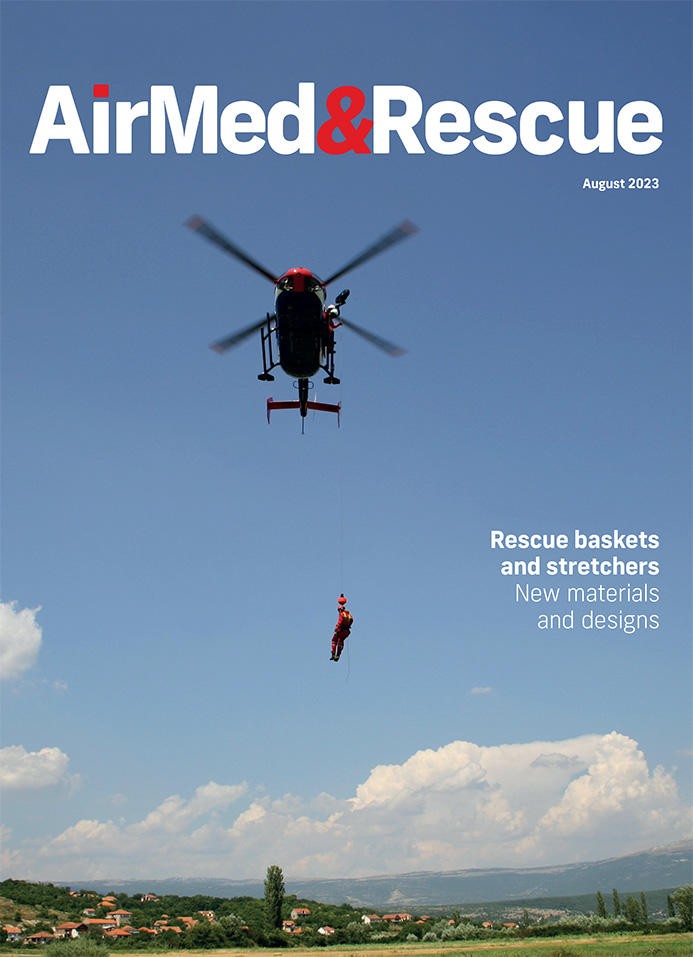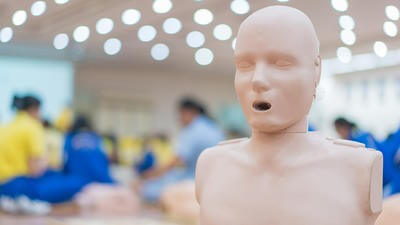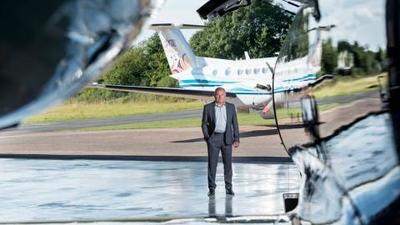Beyond jets – using turboprops in EMS

Oliver Cuenca talks to aviation and emergency medical services experts and operators about the use of turboprop air medical aircraft
While many modern fixed-wing air medical services typically have a heavy reliance on jet-powered aircraft, there are still plenty of operators who prefer to use a more ‘traditional’ form of propulsion – the turboprop. While these aircraft offer a lower range than their jet equivalents, they offer advantages in terms of flexibility, cost-effectiveness and ease of maintenance.
A more economical option
Dr Rahul Sardar, Co-Founder and Director of ICATT Air Ambulance Service, argued that a key benefit of using turboprop aircraft over jets and helicopters is cost-effectiveness. His company makes extensive use of turboprop aircraft such as Beechcraft B200 and B250, and Cessna C90 planes in its operations across India and the Maldives.
Foremost, he explained, turboprops offer significant cost savings over less economical alternatives. Being light aircraft, their fuel costs are far smaller than they would be in a jet-based equivalent. Additionally, Sardar explained that ‘there is a reduced downtime because of the availability of parts and services in India compared with … jets and helicopters’. Reducing downtime is ultimately the ‘main differentiator’ in how ICATT decides what aircraft to operate.
Beyond this, he explained that another reason for the popularity of turboprops with ICATT is the availability of pilots. He explained that ‘most of the pilots coming out of flying schools get type rated for Beechcraft’ and take on jobs flying medical operations as an ‘easy transition’ towards airline flying. Sardar added: “Most of the ex-armed forces pilots with open multi-engine ratings get type rated on Beechcraft for the same reasons.” Consequently, the required experience to fly turboprop aircraft is easier to come by than it might be for more complex aircraft.
Jeffrey Lenorovitz, Vice President of Communications for North America at Daher – the manufacturer of the popular Kodiak 100 and 900 turboprop fixed-wing aircraft, agreed that lower costs are often a key consideration for many operators when using turboprops in air ambulance roles. “A turboprop engine requires less maintenance than a piston engine, and is less expensive to operate than a jet engine,” he said.
He notes that ‘in the case of the Kodiak, the aircraft was designed from the start for operations in remote areas’ – a common feature of many modern turboprops – and so was ‘tailored for in-the-field maintenance and repair’.
Additionally, Lenorovitz argued that while turboprops offer better cost-effectiveness than jets and rotorcraft, they also offer better operating costs than smaller piston-powered aircraft as well. He explained that turboprop engines typically run on Jet A fuel, ‘which is less expensive, and becoming more available, than the aviation gas used in piston engines’.
“Additionally,” he said, “turboprop engines can run on sustainable aviation fuel (SAF), which is a key element of the air transportation sector’s move towards lower emissions – with the goal to eventually decarbonize aviation.”
Peter Broschofsky, Chief Operating Officer of Australian air medical charity CareFlight – which operates a permanent fleet of 17 aircraft, of which eight are King Air turboprops – agreed: “Turboprop planes also tend to have a lower capital cost than our jets and rotary-wing aircraft, [while] maintenance costs also tend to be slightly lower over the aircraft’s lifetime.” A key contribution to the lower maintenance costs, he explained, is the popularity of small fixed-wing turboprops in the civilian market, meaning that ‘spare parts, trained pilots and maintenance engineers are generally available’.
One of the main advantages of using turboprops is the ability to get closer to patients’ actual locations.
Short take-off and landing
Turboprop aircraft are particularly popular for emergency medical services (EMS) operations in rural areas – primarily due to what Lenorovitz identifies as their ‘short take-off and landing (STOL) capabilities’.
Lisa Humphries, Business Development Director at the UK-based Capital Air Ambulance, an air medical company that operates a fleet of Beechcraft King Air 200s, agrees. She argued that one of the main advantages of using turboprops is the ability to get closer to patients’ actual locations. “They can land on smaller runways than jets – so often we find we are able to get closer to the patient’s location, for a quicker repatriation,” she explained.
Sardar agreed. While he noted that efforts are being made by the Indian government to develop the infrastructure in such areas to permit access to larger aircraft, he explained that, for the moment, turboprops still have an edge in this area for EMS providers such as ICATT.

Turboprop’s main competition when serving local areas, Sardar continued, comes from rotorcraft, which offer faster speeds of mobilization than fixed-wing turboprops, and can land at ‘non-prepared areas and temporary landing sites’ if necessary. However, turboprops remain the aircraft of choice in India due to helicopters’ higher cost of operations, relative scarcity and current lack of a ‘robust HEMS system’ in the country – although this is changing.
Operating in remote locations
Sardar added that while jets may be beneficial when conducting fixed-wing aircraft over long distances of over 750NM in terms of speed and reduced flight hours, turboprops are far more cost effective when carrying out more local missions. He highlighted: “In India, most of the centralized tertiary medical centers are in the major cities of Chennai, Delhi, Hyderabad, Kolkata and Mumbai – the catchment area of these tertiary centers falls within a 750NM radius.” Consequently, turboprop aircraft have a ‘clear cost advantage’ when conducting interhospital transfers, particularly as ‘in most cases, speed and transit time do not matter’ for such missions.
A turboprop does have a shorter range than a jet, but it can also land in some remote locations where jet aircraft may not be able to
Turboprops come in particularly useful to support ICATT’s operations in the Maldives. Sardar explained that the Maldives is a very unique place in terms of its geography, ‘it has more than 1,000 islands’ spread over an area roughly 900km in length and 300km in width, ‘with a population of half a million people’. Additionally, the country attracts over 1.8 million tourists every year.
In response to this challenging geography, ICATT Maldives introduced a mixture of Twin Otter seaplanes and Beechcraft land-based turboprop planes. “Seaplanes are fantastic platforms, and can reach any part of the Maldives for an emergency response – but they are restricted because they only fly visual flight rules (VFR). They are non-operational after dark,” explained Sardar. “That’s when the Beechcraft comes into play, for dusk and overnight operations.”
Broschofsky agreed, arguing: “A turboprop does have a shorter range than a jet, but it can also land in some remote locations where jet aircraft may not be able to.” This includes ‘remote operations where runways and landing strips may be shorter and/or dirt’.
He argued that over shorter ranges, ‘the flight times for jets and turboprops are broadly similar, and so the flexibility of turboprops to deliver treatment directly to the patient – often located at inaccessible places – is the primary factor’. However, Broschofsky conceded that over longer ranges, ‘the increased speed of the jets becomes dominant in delivering the patient quickly’.
Humphries argued that range can be a ‘disadvantage’ when using turboprop aircraft for emergency medical transfers. However, she argued that despite being less able to perform direct, long-distance flights, it is possible to ‘perform a fuel stop en route to reach further away destinations … depending on the medical condition of the patient’.
Best used alongside other options
Ultimately, however, both Broschofsky and Humphries argued that turboprop aircraft worked best in delivering EMS when operated alongside other aircraft types.
Humphries stated: “Jets also have their place and advantages, so for longer repatriations we partner with other European Aeromedical Institute (EURAMI) accredited companies.”
Broschofsky also argued that in CareFlight’s case, turboprop aircraft are best used as part of a mixed fleet, allowing particular aircraft to be used ‘depending on the specific individual requirements’.
“It just makes sense to have a complementary fleet of different aircraft that can perform a broad array of different tasks, so that we can perform missions across all the challenging environments that the Australian landscape provides.”
More space, lower altitudes, less noise
Humphries added that additionally, a large turboprop can offer more cabin space than an equivalent jet aircraft. “Our King Airs are very accommodating in the cabin, and with a stretcher patient and two medical staff, we are still able to offer a seat for a companion with some luggage – subject to the patient’s medical condition, of course,” she explained. “This is a big advantage over the small jets often used for air ambulance missions, and it is comforting for the patient to have their companion with them. Plus, it is of course also more cost effective for the insurer, since there is no requirement to purchase a separate airline ticket for them.”
Broschofsky, meanwhile, said that while ‘maximum cruising altitudes are also lower for turboprops when compared with jets,’ because the journeys being covered by turboprops tend to be shorter, ‘reaching maximum altitude is, much of the time, irrelevant’. He added that some critical patients actively need to be flown at altitudes low enough to not require cabin pressurization, ‘so, for these, maximum altitude is also irrelevant’.
Turboprop aircraft offer a lower noise footprint than a jet – enabling it to operate at all hours and potentially avoid local ‘noise curfews
However, Sardar added that one disadvantage of using turboprops to fly at a lower altitude – particularly when ‘living in a tropical country with a varied geographical landscape … and unpredictable weather systems’ – is their vulnerability to turbulence. “Jets have a clear advantage in flying in these conditions … especially when we use aircraft for organ airlifts,” he explained.
Finally, Lenorovitz argued that turboprop aircraft offer a ‘lower noise footprint than a jet’ – making it more ‘neighbor-friendly at airports, and in many cases, enabling it to operate at all hours’ and potentially avoid local ‘noise curfews’ – a benefit for emergency air medical operators who may be called out on a mission at a late hour.

A strong alternative
While turboprop planes may appear to be something out of the past, they should not be underestimated. They are modern, highly effective aircraft that have a lot to offer in the field of EMS transport. While they may lack the smooth ride of a jet, they make up for it in terms of benefits such as cost – for both the operator and the patient and insurer – as well as the availability of pilots, among other things. At their best, they can be the only way to provide effective EMS services to remote regions. But even outside of such situations, they can offer a strong alternative to jets and helicopters as part of a mixed fleet.

August 2023
Issue
We have a wonderful edition, covering aerial ECMO provision; hoisting and the lessons to be learned; the benefits of fixed-wing air ambulances; preparation for fire seasons; progress towards sustainable aviation fuel; and the variety rescue baskets; plus more of our regular content.
Oliver Cuenca
Oliver Cuenca is a Junior Editor at AirMed&Rescue. He was previously a News and Features Journalist for the rail magazine IRJ until 2021, and studied MA Magazine Journalism at Cardiff University. His favourite helicopter is the AW169 – the workhorse of the UK air ambulance sector!

